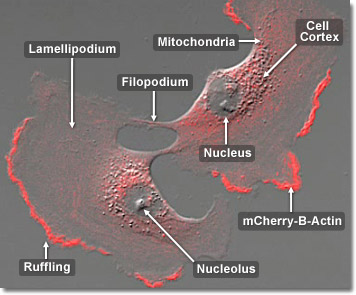Actin is a globular protein found in all eukaryotic cells, with the exception of nematode sperm. One of the most highly-conserved proteins, actin differs by no more than 20% in species as diverse as algae and humans. It is the monomeric subunit of microfilaments—one of the three major components of the cytoskeleton—and of thin filaments, which are part of the contractile apparatus in muscle cells. Actin participates in many important cellular functions, including muscle contraction, cell motility, cell division, cytokinesis and the establishment and maintenance of cell junctions and cell shape.
Video 1 - Run Time: 15 Seconds
Video 2 - Run Time: 41 Seconds
Video 3 - Run Time: 59 Seconds
Video 4 - Run Time: 58 Seconds
Video 5 - Run Time: 25 Seconds
Video 6 - Run Time: 15 Seconds
Video 7 - Run Time: 51 Seconds
Video 8 - Run Time: 66 Seconds
Video 9 - Run Time: 59 Seconds
Video 10 - Run Time: 57 Seconds
Video 11 - Run Time: 49 Seconds
Video 12 - Run Time: 59 Seconds
Distinct, but spatially overlapping actin superstructures have been found to exist. With the advent of fluorescent speckle microscopy, dynamic characteristics of actin superstructures can be measured and used to identify distinct, but spatially overlapping superstructures. In migrating non-neuronal cells, the generation and maintenance of these structures requires the tropomyosin proteins, and although such distinct units have not been identified in growth cones, all of the required components are present.

B-actin exists in nonmuscle cells as either globular actin (G-actin) or filamentous actin (F-actin), which is arranged as a string of uniformly oriented G-actin subunits in a tight helix. Although B-actin is traditionally considered to be a structural protein that organizes and maintains the shapes of cells, it is also a signaling molecule. Several studies have demonstrated that B-actin associates with and regulates NOS-3 (nitric oxide synthase type 3). In the digital video presented above, human glioblastoma cells (U373 line) are expressing a fusion of monomeric Kusabira Orange (mKO) fluorescent protein to human beta-actin.